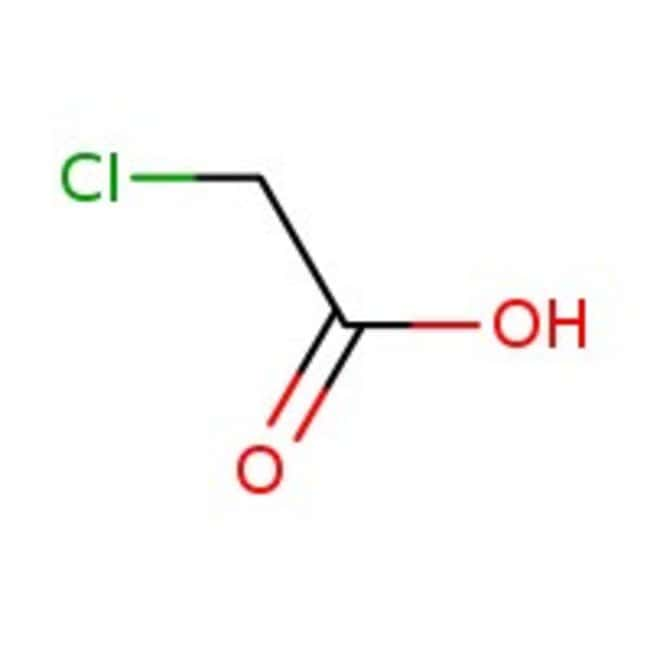Search Thermo Fisher Scientific
Thermo Scientific Chemicals
Chloroacetic acid, 99%, Thermo Scientific Chemicals
Catalog number A11482.0B
also known as A11482-0B
Price (USD)/ Each
91.65
Online exclusive
102.00 Save 10.35 (10%)
-
Quantity:
1000 g
Price (USD)/ Each
91.65
Online exclusive
102.00 Save 10.35 (10%)
Chloroacetic acid, 99%, Thermo Scientific Chemicals
Catalog numberA11482.0B
Price (USD)/ Each
91.65
Online exclusive
102.00 Save 10.35 (10%)
-
Chemical Identifiers
CAS79-11-8
IUPAC Name2-chloroacetic acid
Molecular FormulaC2H3ClO2
InChI KeyFOCAUTSVDIKZOP-UHFFFAOYSA-N
SMILESOC(=O)CCl
View more
Specifications Specification Sheet
Specification Sheet
Assay (Aqueous acid-base Titration)≥98.5 to ≤101.5%
Water Content (Karl Fischer Titration)≤0.5% (non-U.S. sourced material)
Appearance (Color)White
CommentMaterial sourced in the U.S. and in other countries
Identification (FTIR)Conforms (non-U.S. sourced material)
View more
Chloroacetic acid is used in the production of pharmaceuticals, dyes, detergents, synthetic caffeine, glycine and thioglycolic acid, which acts as a stabilizer in PVC. It acts as a precursor to glyphosate and adrenaline. It also serves as a preservative and bacteriostat. Further, it is used as surface active agents and photosensitive chemicals. It is also used in the O-alkylation of salicylaldehyde and an active component in cosmetics. In addition, it is involved in the preparation of thickening agent carboxymethyl cellulose and carboxymethyl starch.
This Thermo Scientific Chemicals brand product was originally part of the Alfa Aesar product portfolio. Some documentation and label information may refer to the legacy brand. The original Alfa Aesar product / item code or SKU reference has not changed as a part of the brand transition to Thermo Scientific Chemicals.
Applications
Chloroacetic acid is used in the production of pharmaceuticals, dyes, detergents, synthetic caffeine, glycine and thioglycolic acid, which acts as a stabilizer in PVC. It acts as a precursor to glyphosate and adrenaline. It also serves as a preservative and bacteriostat. Further, it is used as surface active agents and photosensitive chemicals. It is also used in the O-alkylation of salicylaldehyde and an active component in cosmetics. In addition, it is involved in the preparation of thickening agent carboxymethyl cellulose and carboxymethyl starch.
Solubility
Soluble in water, methanol, acetone, diethyl ether, benzene, chloroform and ethanol.
Notes
Incompatible with strong oxidizing agents, strong bases and strong reducing agents.
Chloroacetic acid is used in the production of pharmaceuticals, dyes, detergents, synthetic caffeine, glycine and thioglycolic acid, which acts as a stabilizer in PVC. It acts as a precursor to glyphosate and adrenaline. It also serves as a preservative and bacteriostat. Further, it is used as surface active agents and photosensitive chemicals. It is also used in the O-alkylation of salicylaldehyde and an active component in cosmetics. In addition, it is involved in the preparation of thickening agent carboxymethyl cellulose and carboxymethyl starch.
Solubility
Soluble in water, methanol, acetone, diethyl ether, benzene, chloroform and ethanol.
Notes
Incompatible with strong oxidizing agents, strong bases and strong reducing agents.
RUO – Research Use Only
General References:
- A convenient one-pot alternative to the Knoevenagel or Horner-Wadsworth-Emmons reactions for the synthesis of ɑ-unsubstituted cinnamic acids involves the reaction of chloroacetic acid with dimethyl phosphite in the presence of sodium methoxide, and treatment of the resulting phosphonoacetate salt with a benzaldehyde: J. Org. Chem., 46, 2514 (1981):
- For a more general version of this reaction, applicable to the synthesis of a variety of substituted acrylic acids, see 2-Bromopropionic acid, A17569 .
- Scialdone, O.; Galia, A.; Sabatino, S.; Mira, D.; Amatore, C. Electrochemical Conversion of Dichloroacetic Acid to Chloroacetic Acid in a Microfluidic Stack and in a Series of Microfluidic Reactors. Chem. Electro. Chem. 2015, 2 (5), 684-690.
- Teng, Y.; Liu, Y.; Jiang, J. Preparation of Carboxyl-End-Group Poly(methyl methacrylate) and Polystyrene with Low Polydispersity by Atom Transfer Radical Polymerization Initiated with Chloroacetic Acid. Asian J. Chem. 2015, 27 (9), 3254-3258.

